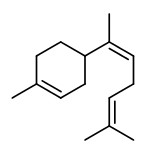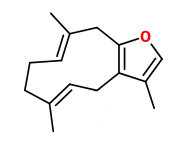Commiphora guidottii Chiov. - syn.Commiphora opobalsamum - Burseraceae - scented myrrh, opopanax, Süße Myrrhe
Shrub or tree, up to 5m tall, native to Somalia; bark greenish or brownish; leaves composed of 3 or 5-7 leaflets, oval to broadly oval; flowers very small, cream coloured; fruit rounded, 1cm in diameter, with a single stone.
„Scented myrrh is a yellowish-red sweet-smelling resin. It oozes from damaged bark of certain trees in the genus Commiphora. The resin gums up the mouthparts of attacking insects, such as termites, and its antibiotic properties protect the trees against infection through wounds in their bark. As with frankincense, myrrh is harvested by making an incision in the trunk of the tree, from which the gum then seeps out.
The resin from C. guidottii is added to cattle feed to improve milk production. Somali people use it to treat stomach complaints, to facilitate the withdrawal of the placenta after childbirth, and for the topical treatment of wounds. The resin from Commiphora species is traded under the names scented myrrh, or opopanax. Confusingly, the name opopanax is also applied to a gum derived from Opopanax chironium (a herb in the carrot family, Apiaceae). Scented myrrh is exported to Europe where it is used in the perfume industry, and to China (which comprises the largest market for this resin).“
http://www.kew.org/science-conservation/plants-fungi/commiphora-guidottii-scented-myrrh
α-Santalene, α-bisabolene, and furanodiene were identified as major and β-santalene, β-bergamotene, β-farnesene, and β-bisabolene the minor components of the volatile oil fraction from the bark exudate of C.guidotii.
[Constituents of essential oil of Commiphora guidotti., Craveiro, A., Planta Med 48, 1983, 97-8]
„It is concluded that the botanical origin of scented myrrh (bissabol or habak hadi), a major article for export from Somalia since ancient times, is Commiphora guidottii (Burseraceae) and not C. erythraea as generally has been presumed.“
[The botanical origin of Scented Myrrh (Bissabol or Habak Hadi). Thulin, M., Claeson, P., Economic Botany, Vol.45(4), 1991, 487-494]
Main components of the essential oil of C.guidottii resin (opopanax) from Ethiopia (5% yield, hydrodistillation) were (E)-β-ocimene (33%), (Z)-α-bisabolene (22%), α-santalene (15%), (E)-β-bergamotene (6%), and α-bergamotene (3%).
[Essential oils of some Boswellia spp., myrrh and opopanax., Başer, K.H.C., Demirci, B., Dekebo, A., Dagne, E., Flavour and fragrance journal, 18(2), 2003, 153-156]
„Our work showed that commercial opopanax oil is effectively prepared from C. guidottii, as the analyses
reported in the 1960s are close to the one reported by Başer [in 2003].“
[Chemical composition of the essential oil of Commiphora erythraea., Marcotullio, M.C., Santi, C., Mwankie, G., Curini, M., Natural product communications, 4(12), 2009, 1751-4]

